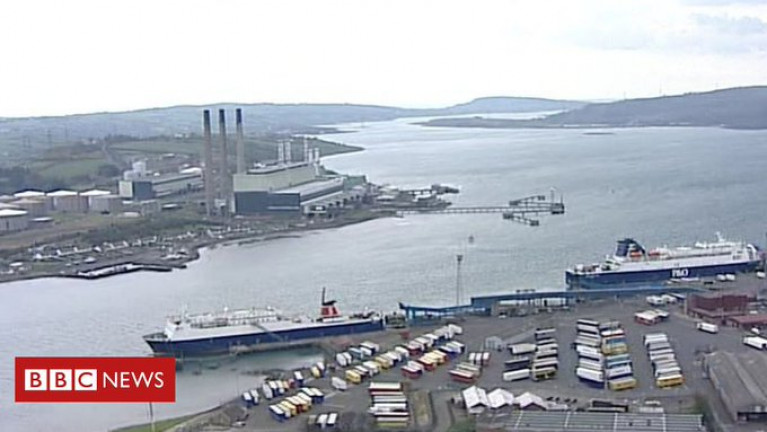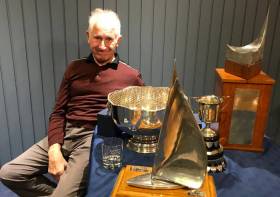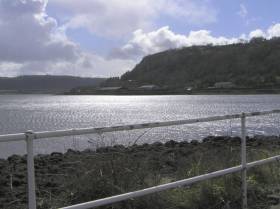Displaying items by tag: Larne Lough
Judgement has been reserved in campaigners’ legal bid to overturn the decision to approve the excavation of gas storage caverns under Larne Lough.
As the Belfast Telegraph reports, the coalition of local campaigners — under the banner of No Gas Caverns — and Friends of the Earth NI took their case to the Court of Appeal after their application for judicial review was dismissed last August.
Among their claims, they say that hyper-saline discharges from the excavation process would create a marine wildlife “dead zone” in the lough.
They also contended that Edwin Poots — then minister at the Northern Ireland Department of Agriculture, Environment and Rural Affairs (DAERA) — was required to seek consent from the NI Executive before green-lighting the project in November 2021.
Counsel for DEARA, however, insisted that Poots had legal authority to act unilaterally in his decision to award the marine licence to Islandmagee Energy, a subsidiary of Infrastrata-owned Harland and Wolff, for the excavation of seven 1,350m-deep caverns with an intended storage lifespan of 40 years.
The Belfast Telegraph has more on the story HERE.
Campaigners against plans to excavate caverns for gas storage under Larne Lough took to its shores last weekend to reaffirm their opposition to the proposals.
And as Belfast Live reports, the protest at Browns Bay Beach on Sunday 7 January also heralded their upcoming hearing at the Court of Appeal, following on from last August’s dismissal of their application for judicial review.
Islandmagee Energy, a subsidiary of Infrastrata-owned Harland and Wolff, won a marine licence to excavate seven 1,350m-deep caverns under the lough when Edwin Poots, then minister at the Northern Ireland Department of Agriculture, Environment and Rural Affairs (DAERA), green-lit the project in November 2021.
The works would result in up to 24,000 cubic metres of brine being discharged into the inlet every day — a prospect that environmentalists and other campaigners say will have a significant impact on marine wildlife and habitats that they argue has not been properly assessed.
Belfast Live has much more on the story HERE.
Campaigners Appealing Dismissal of Legal Challenge to Larne Lough Gas Cavern Plans
Local campaigners are taking their challenge against proposed gas caverns under Larne Lough to the Court of Appeal, following its dismissal by the High Court in August.
As previously noted on Afloat.ie, all seven grounds of the legal challenge brought jointly by campaign groups No Gas Caverns and Friends of the Earth NI were dismissed at the High Court in Belfast.
But as Belfast Live reports, the groups are mounting an appeal of Justice Michael Humphreys’s ruling under two grounds: failure to refer the marine licence applications to the Executive Committee; and the taking into account of an irrelevant consideration, namely the fossil fuel scheme’s promise of a ‘community fund’.
The groups argue that former Environment Minister Edwin Poots acted unlawfully when he approved a marine license for plans to store half a billion cubic metres of natural gas under the lough.
It’s feared that “hyper-saline” water that would be released by carving out the salt caverns beneath the lock would threaten vulnerable marine wildlife and even create a “dead zone”.
Belfast Live has more on the story HERE.
Legal Challenge Over Larne Lough Gas Caverns Is Dismissed
The High Court in Belfast has dismissed a legal challenge against proposed gas caverns under Larne Lough.
As previously reported on Afloat.ie, judgment was reserved in early May in the "complex" and "significant" judicial review into granting a marine licence for the plans to store half a billion cubic metres of natural gas under the lough.
Northern Ireland’s main conservation groups have been united against the proposals on environmental grounds, with a number of demonstrations taking place earlier this year.
According to BBC News, Justice Michael Humphreys dismissed all seven grounds of the legal challenge brought jointly by campaign groups No Gas Caverns and Friends of the Earth NI.
The latter said the ruling on Thursday (31 August) is “incredibly disappointing for our environment”.
BBC News has more on the story HERE.
Judgment Reserved in ‘Complex’ and ‘Significant’ Review of Larne Lough Gas Caverns Licence
Judgment has been reserved in the judicial review into the granting of a marine licence for the excavation of gas storage caverns under Larne Lough.
After four days of submissions at Belfast High Court, on Friday (5 May) Justice Michael Humphreys described the case as “complex” and “significant”, according to BelfastLive.
As previously reported on Afloat.ie, Northern Ireland’s main conservation groups have come out against the plan to develop the gas storage caverns underneath Larne Lough on environmental grounds.
In the most recent of a series of demonstrations, some 30 swimmers took to the waters of Larne Lough on Saturday 22 April to protests plans to store half a billion cubic metres of natural gas under its bed.
Representing the campaigners, Barrister Conor Fegan warned of a damaging impact on marine wildlife in the area, noted how it would lock Northern Ireland into extended fossil fuel dependence and questioned suggestions that the caverns could be used to store hydrogen instead.
King’s Counsels representing DAERA and Islandmagee Energy, meanwhile, sought to mollify concerns over the approval process for the licence and minimise the potential for discharge in the sensitive sea life zone.
BelfastLive has much more on the story HERE.
Swimmers Protest Gas Cavern Plans for Larne Lough
Some 30 swimmers took to the waters of Larne Lough on Saturday (22 April) in protest over plans to store half a billion cubic metres of natural gas under its bed, according to BBC News.
As previously reported on Afloat.ie, Northern Ireland’s main conservation groups have come out against the plan to develop the gas storage caverns underneath Larne Lough on environmental grounds.
The protest followed a similar action earlier this month called ‘Boots on the Beach’, in which 200 people marched along Brown’s Bay beach in Islandmagee in opposition to the gas caverns.
Campaigners, who have been raising funds for a judicial review due to begin early next month, fear that the “hyper-saline” water that would be released by carving out the salt caverns beneath the lock would threaten vulnerable marine wildlife and even create a “dead zone”.
It’s also feared that the project would impact key records collected by the Irish Whale and Dolphin Group used to determine the status of cetaceans in Irish waters.
However, the firm behind the project — which is owned by Harland & Wolff, formerly InfraStrata — counters that it would create hundreds of jobs in the area and bring “significant economic and social benefits” to the region.
BBC News has more on the story HERE.
Larne Regatta Gets Unexpected GB Row Challenge Visitors
Larne Lough Weekend Regatta, held on the first weekend in July, drew visitors from Carrickfergus SC and Ballyholme YC on Belfast Lough, and a surprise visit too when Sea Legs, one of the rowing boats taking part in the GB Row Challenge around Great Britain, was towed by the Larne lifeboat into the Harbour with a damaged rudder.
The challenge started from London on 12th June, but all three boats were rescued over the weekend of 25th June - one off the Welsh coast taken to Milford Haven, another off the Co. Antrim coast, and one by the Newcastle Co.Down lifeboat taken to nearby Ardglass – this was Sea Legs. This same boat restarted the challenge but was unfortunate to suffer rudder damage at Muck Island, off Islandmagee on the Antrim Coast and was towed by Larne lifeboat to Wymer’s Pier at East Antrim Boat Club in nearby Larne Harbour. The rudder was repaired by some club members.
 SEA LEGS in Larne Harbour Photo: Michael Kane
SEA LEGS in Larne Harbour Photo: Michael Kane
And so the Regatta continued with the visiting Carrickfergus Corby 29 Elixir, (Brian and Ryan Wilson) taking first place in NHC, one point ahead of Peter Doig’s J92 Jack.
 Alan Knox's Cheeky Monkey (5799) and Artemis (Gordon and Heather Kane) at Larne Lough regatta Photo: Sue Kitson
Alan Knox's Cheeky Monkey (5799) and Artemis (Gordon and Heather Kane) at Larne Lough regatta Photo: Sue Kitson
But a successful challenge was not to be for Sea Legs as the same boat had further difficulties on 4th July when the Red Bay lifeboat from Cushendall on the Antrim coast was called just after midnight to go to its aid off Machrihanish, near the tip of the Mull of Kintyre in Scotland. The crew had managed to anchor the boat and all five were airlifted to safety by a Coastguard Rescue Helicopter. RNLI Lifeboat crew from Campbeltown was also in attendance. Then followed an unusual mission for Mull of Kintyre Sea Adventures who were called to take the crew to retrieve the anchored boat and tow it the 30 miles back to Campbeltown on the east of Kintyre.
East Antrim BC Commodore Lucy Whitford and her team had given the rowers lunch and a number of members fixed the rudder before heading back on the water for the afternoon racing. Lucy said “We were pleased to be able to extend our regatta hospitality to the crew and also help them fix the damaged rudder. We had wished them well on their onward passage but understand they have chosen to retire from the challenge”.
Gas Storage Project in Larne Lough: Conservation Groups Oppose Plan
The main conservation groups in Northern Ireland have come out against a plan to develop gas storage caverns underneath Larne Lough.
They are opposed on environmental grounds and as BBC News NI reports, they believe the potential impact on wildlife and habitats has not been properly assessed.
Infrastrata, Harland and Wolff's new owner, is the firm behind the project.
John Wood, the firm's chief executive, said it had completed a "robust series of surveys and studies", which had been sent to Stormont departments.
The firm believes its Larne Lough storage facility will create "hundreds of jobs" and provide security of power supply for a generation.
The project would see seven large storage caverns hollowed out using solution mining.
The brine solution created would be pumped across land before being discharged into the North Channel near Islandmagee in County Antrim.
The sea at Islandmagee is a protected area, as is Larne Lough which supports important tern colonies.
For much more on this development click here.
A septuagenarian yachtsman has scooped the top award at the recent East Antrim Boat Club prize-giving event, writes Tom Jobling.
Maurice Adams, who has Parkinson’s, received the solid silver trophy — presented to EABC by the Gingles family in the mid 1970s — at the gala awards evening at the Larne Lough club over the Halloween weekend.
What makes Maurice’s achievement memorable is that Larne has no marina pontoon facilities so, just as his competitors do, he must get out to his craft, a Nova 27, via an inflatable dinghy, and scramble aboard.
Owner Eddie Cameron remarked: “Even with his dual walking aids, Maurice is not the most mobile man ashore these days, but each evening, regardless of the conditions, and as we draw alongside Sahure, he’’s up over the guard-wire and into her cockpit like a ship’s cat up a pole.
"Then with tiller clutched, he becomes ‘made-over’ … back into yacht-racing mode.”
As well as winning the top award, the Sahure crew, with Maurice driving, also won their class within the club’s points racing season.
But Maurice is no stranger to success. Formerly a member of the now-defunct Larne Rowing & Sailing Club, he has raced various sailboats over his long career afloat on Northern Ireland waters: Flying 15s, Highland 18s and number of cruisers.
“Maurice Adams,” Commodore Steven Kirby remarked, as he held ready the trophy, “is not famed for his time-keeping these days — well, other than on the starting line.”
Totally unaware of his award, Mr Adams arrived at the Boat Club as the final prizes were being handed out. His trophy, however, was already in the safe hands of his ever-caring crew.
Diesel Spill Threat To Wildlife In Larne Lough
#Larne - Coastal wildlife in Co Antrim is under threat after a significant diesel spill from a Caterpillar plant in Larne at the weekend, as the News Letter reports.
The plant machinery firm faces likely enforcement action after 40,000 litres of red diesel leaked into Larne Lough via a storm drain – news of which was not made public till days later, according to the Belfast Telegraph.
As the Northern Ireland Environment Agency moved to assure that the spill's impact on marine life would be minimal, conservationists remain concerned as the diesel slick was seen drifting towards The Gobbins, home to many protected seabird species.
Spot checks of affected parts of the Antrim coast have as yet found no injured birds, but Ulster Wildlife maintains that the spill "could have potentially devastating impacts on breeding birds".
The News Letter has more on the story HERE.


























































